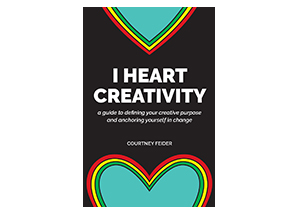The Five Elements of Practiced Creativity
By Courtney Feider
Change is a state that happens in every business and in every person; it’s impersonal and an inevitable fact. Transition is more of a psychological shift and requires a person to feel the feelings of change and lean into—or away from—a move that alters their reality and transforms what’s next. Disruption is an election, a transformative decision. It’s the ownership of possessing a change and transformation process and further adopting the opportunity to put the timing of those changes into motion on your own timetable. It’s about powerful, passionate moves and completely owning the story, the success, the failure, and all of the outcomes.
With the market crash of 2008, synchronicity of market growth and development, mobile technology development, and now the steady and rapid marketplace shift with the lemming-like retirement of tens of thousands of sixty-something-year-olds per day, we are in a state of nearly perpetual disruption. It’s too late for people to hide from it. And, for most, it’s absolutely terrifying.
Creative “disruption” is where we begin. But it’s not where we stay, nor where we should end up. It’s just the surprise of the deafening thunderclap and the warm summer rain that enlightens us, wakes us, and gets us moving.
In all of my work, from coaching individuals to working with large corporations, these are the elements of Practiced Creativity we examine, dissect, and diagnose together:
1. THE CREATIVITY OF SUSTAINABLE DISRUPTION
The creative disruption can be personal or it can be broad and professional, but it has to be chosen and mapped to a strategy, which makes it feasible, repeatable, adaptable, and successful. This pin in the map starts the shift.
2. THE CREATIVITY OF SELF
From the point of creative disruption, the creativity of self is the development nexus of the core leader who will own the change. This is the flag-planter. With the right personal leadership strategy, this person can come from any background, experience, or behavioral type and be successful with moving creative disruption ahead as long as they both support and are supported, are responsible for and work with the big picture plan, and model the disruption in positive ways for other members of their management team, division leaders, departments, and every staff member of the organization and encourage the other leaders to take similar personal responsibility and accountability. A sound personal leadership strategy is backed by a rock-solid personal brand; together these create inherent executive presence and natural confidence. You’re being supported for what you’re good at. You’re free to be yourself. You’re well matched to your job. You’re finally liberated from feeling as if you have to do all of the things at maximum level by yourself.
3. THE CREATIVITY OF DAILY WORK
The level of commitment and planning that begins with personal leadership moves from individual leaders to whole teams and becomes a system by which an organization functions and an integrated part of the way they use inclusion as a daily practice. Creativity must be practiced, maintained, and clearly and consistently present on the business agenda.
4. THE CREATIVITY OF TEAMS
Small teams must start to speak to each other differently. They must get to know each other on a personal level and expose themselves from a point of vulnerability, explaining what works for them and what doesn’t, how it affects their lives, and why they want the change they want for the practice of the business. They must exercise soft skills and empathy in volume quantity, and they must be willing to exercise gentle and respectful discourse, keeping safety as the number one priority of the team environment. Those who do will chart more creativity, more progress, and more results.
5. THE CREATIVITY OF THE MARKETPLACE
Once all of these wheels are simultaneously in motion and moving like in synchronicity, there is an opportunity to address the company’s brand, marketplace approach, and marketplace attraction with new and different energy. The community that wants the good or service being produced will naturally and energetically respond to the innovation in progress, the business results, and the improved product and will be ready to hear a vulnerable message that mimics the openness the organization has been working so diligently to create. The consumer will feel that they can trust the brand and that the brand has their best interest at heart. And because the vast majority of our global purchasing audience is monopolized by women—who buy for all members of their families, of all ages—and Millennial buyers—in age or mindset—this personal approach and willingness to be real, and to wear our hearts on our sleeves will be infinitely and lastingly attractive. Talent with the same priorities will want to work for these companies and retain their employment because they feel validated, respected, and cared for. Attention will be paid routinely to brand integrity, quality, and consistency in executive presence. Culture will shift, productivity will rise, and yes, market share will increase.
Excerpted from the forthcoming book, I Heart Creativity by Courtney Feider. It will be available on Amazon in August.


